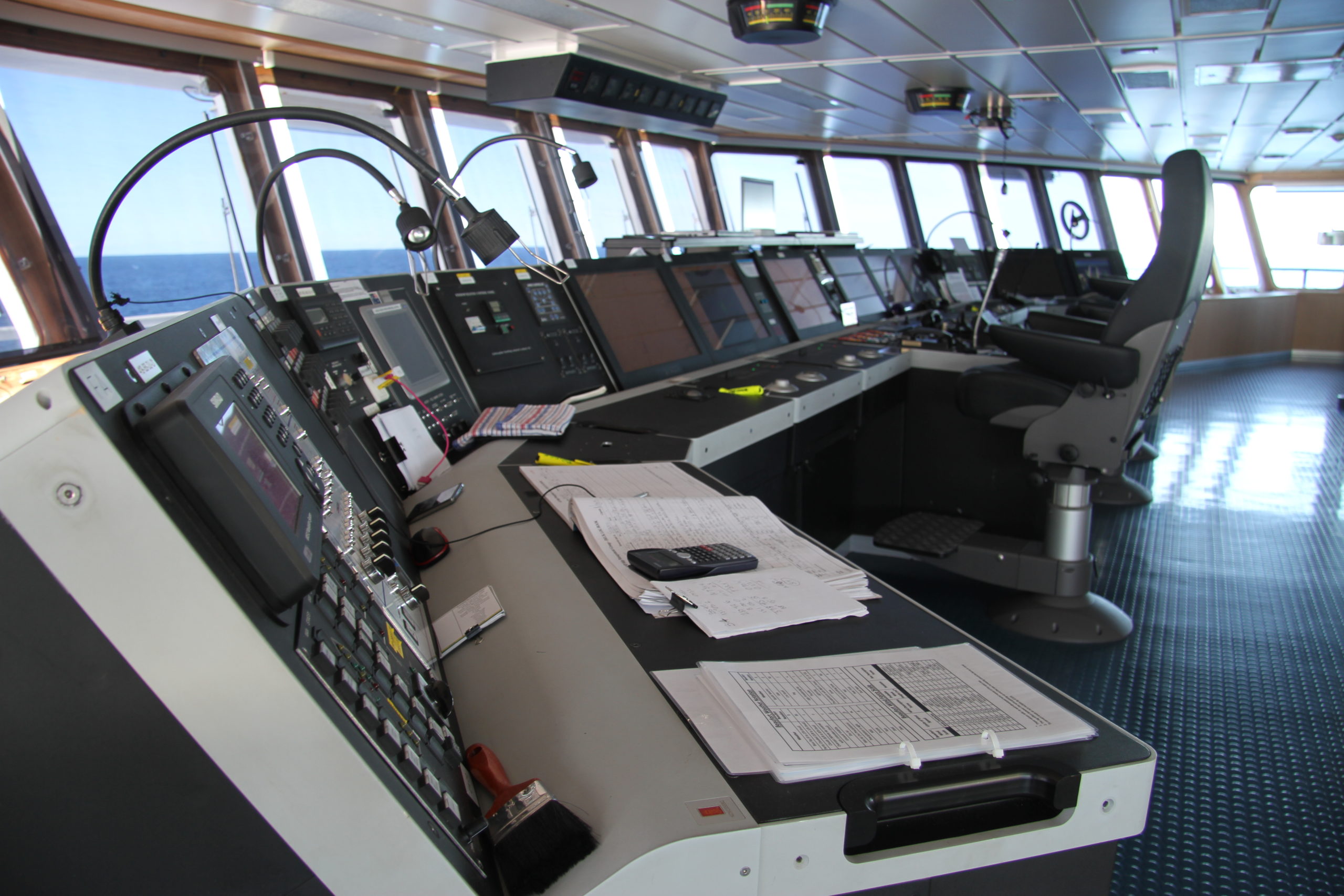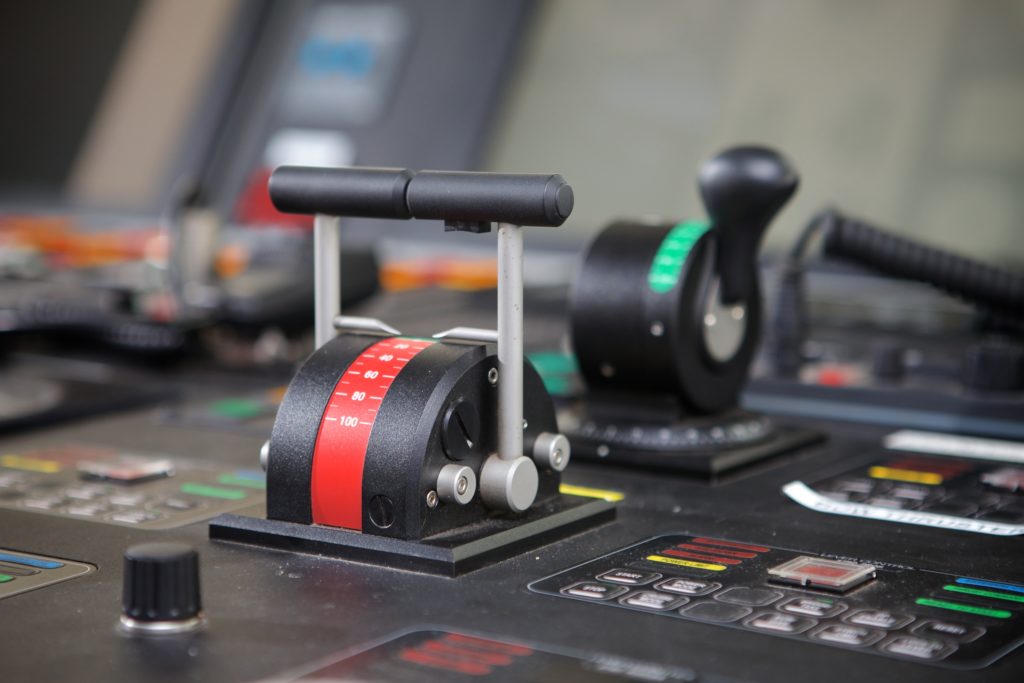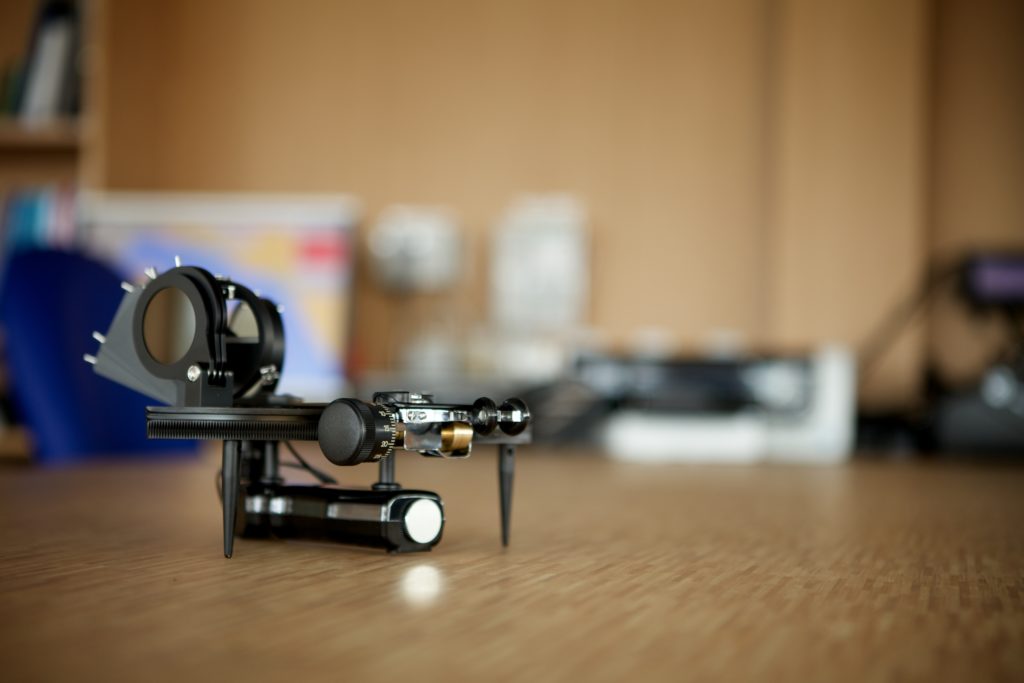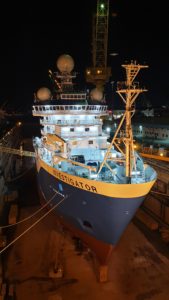
Our RV Investigator specifications are cutting edge, but with a sprinkling of traditional.
Our Research Vessel (RV) Investigator is one smart ship. It’s 94 metres of science-enabling steel, packed with instruments, equipment and sensors that are a data collectors dream! At first glance, the ship is a symbol of nautical modernity. But this contemporary ship is full of contradictions. And many traditions and customs remain.
To understand how such opposites can work together in perfect harmony, I’ll go through the RV Investigator specifications from my time on board last year.
RV Investigator specifications: a modern marvel
RV Investigator normally goes on about a dozen research voyages a year. So, to deliver cutting-edge research, it needs to have the latest tech on board.
Here’s one example. You can pick a spot on the ocean and tell the ship to stay there. As a result, RV Investigator’s Dynamic Positioning System will automatically use the ship’s two main propellers and its (retractable!) bow thruster to hold that position – to within a metre or less.
All despite high winds and rough seas. Keeping the ship stable is thanks to the auto stabilising system. It uses ballast water in giant U-shaped tanks combined with air valves to control the flow of water from one side of the ship to the other depending on the sea conditions. The system, as well as the trim of the ship, means the likelihood of the ship capsizing due to strong waves and winds is zero.
So we’ve touched on some of the aspects that make the RV Investigator specifications so advanced. But where does the tradition come into it? It’s not in what runs the ship, but how.

The bridge is just one aspect of the advanced equipment on board.
Old and new methods
RV Investigator can take you anywhere in the world. Pick any spot in any ocean in the world and the ship’s autopilot can take you there. The ship has incredibly accurate navigational controls.
It has a sophisticated bridge – the place where they drive the ship from – with three independent but duplicated navigation consoles and controls. It’s so sophisticated that not one single paper sea chart is required. The vessel is a paperless ship because of the sophisticated chart plotting system known as an ECDIS (electronic chart display and information system). Well, almost. There is one chart. But that is under glass on a table and is for decoration – not direction.
While there are no written charts, there is a sextant. This is an old instrument used for navigating by the stars! Ships like these are still required to lug about a navigation instrument that harks back to Isaac Newton and others in the 16th and 17th centuries.
So why do we have such an old scientific tool on such a modern research vessel?
If navigation systems fail, all the GPS go down and the radars go on the blink. But don’t worry. Just grab the sextant. All you need to do is hope the skies are clear so you can see some celestial object to ‘shoot’ a bearing. That essentially means the ship’s crew measure the angles between objects in the sky and the ship to work out where in (or on) the world the ship is.
Then jot down some figures and crunch the trigonometry. If you’re a maths whiz, you may get your position down to within a few nautical miles. Just in time to shout: “Land Ho!” as you bump into Circular Quay in Sydney.
Even on a paperless ship, it’s important all the ship’s crew know how to use a sextant so they can safely complete the voyage in the event of a navigation system failure.
At an absolute pinch, RV Investigator’s sextant is useful in the deep Southern Ocean near Antarctica for measuring the height of icebergs. And sometimes communications down south can be quite choppy. So having a sextant in hand will always help everyone get safely back to shore!

Not just for ye olde sailors! The sextant is an important back-up navigational tool for the ship’s team.
Treasure Island
Right at the top of the ship is a huge ‘golf ball’ which houses an advanced weather radar. It’s the only ship-based one of such capabilities in Australia.
The weather radar can detect a slight rain drizzle at 80km and tell you which way the wind will be blowing at Portsea in Victoria next Tuesday. Yet just outside the bridge on both port and starboard are rather weather-worn wooden boxes, which are known as Stevenson Screens. Inside those Stevenson Screens are wet-and-dry-bulb thermometers for measuring relative humidity. Why are they still there when a mobile mini-Bureau of Meteorology hovers over it just metres away? Like the sextant, it’s a required piece of equipment to have on board. If the ship loses power, the team can still observe weather patterns. But ships, including our one, have always had them.
And right above the bridge on Monkey Island, away from the GPS systems and satellite tracking and radars, lies a magnetic compass. Its position means it’s ready to, literally, swing into action if needed. After all, the team calibrate and certify the magnetic compass every year.
Talking ship

RV Investigator taking on the night. Image: Michael Watson.
It’s not just the tools on board that are reminiscent of times past. Ships have always had language and ways of doing things that is their own. That language and those systems have developed over hundreds of years and continue today.
Distances are measured in nautical miles and cables. These are units of measurement that were created for simplified navigation. Essentially, a nautical mile is one 60th of a degree of latitude. Or, to be exact, 1852m.
Now, a cable is one-tenth of a nautical mile or 185.2m. And it’s named after the length of a ship’s anchor chain – which despite appearances is not called a chain, but a cable.
The anchor cable is divided into lengths of 27.5m by shackles. Oddly, considering chain is not a chain at sea, the lengths of anchor cable are called shackles. There are 15 fathoms in a shackle. A fathom is 1.82m, or about six feet in imperial measurement, which was the span of an adult’s outstretched arms.
But the language of the sea doesn’t stop there. You can hear select terms like these: The head (toilet) is inside the brasco (bathroom). Which if you are lucky is just a short walk across the deck (floor) from your rack (bed) in your shed (cabin). Mind you, don’t trip over the rosie (rubbish bin) on the way to doing your dhobi (laundry). Or you will have to fill a bucket with sougee (mopping mix) to washdown the deckhead (ceiling) and bulkheads (walls).
Back to the future
We’ve shown you how the past and present intertwine with RV Investigator specifications. But what can we expect for the future?
RV Investigator has pressed pause on its research voyages for the time being. But we’re hoping to set sail to explore the deep ocean again shortly. Our Marine National Facility (MNF) News page has all the latest information. So you can keep up-to-date like the equipment on board RV Investigator.


22nd August 2020 at 6:26 pm
“…ballast water in giant U-shaped tanks combined with air valves to control the flow of water from one side of the ship to the other depending on the sea conditions” You put this in the wrong category. They should be under “Traditional”, not “Advanced”. You’ve described Fram Anti-Roll Tanks from before the first world war and were popular on German passenger liners of that period until fin-stabilisers were invented.
18th August 2020 at 12:24 pm
Splendid!